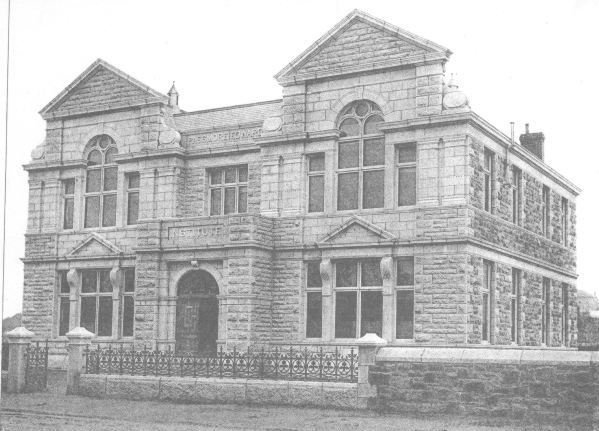Built primarily as a place for technical instruction, at a time of decline in Hayle’s prosperity, the Institute also provided a library and an opportunity for leisure activities.

The building is sombre and dignified, the front finished in rock-faced granite, with close chiselled dressings, and the sides are of elvan filling with granite dressings. The windows on all sides are large and uncluttered, classical and expansive in style, contrasting with the formidable Norman Arch porch with its heavily panelled outer doors and the granite balcony above. The leaded coloured glass panels in the top third of the outer doors, and those in the oak framed arch above, let in a warm,
comforting light, though their simple geometric designs are decoration only. The circular pattern of glass and lead above the door is reminiscent of a dart board, an ironic prediction of the predominately leisure use of the building in the future.
The interior is much lighter and brighter than the outside, even on a winters day. There is much use of genuinly rich brown timber for the staircase and panelling up the stairs, set off by plain, plaster walls painted a pale colour.
Description of the Institute taken from “The Hayle Institute” by Patricia Adams, 1996.
Employees of the Harvey’s foundry established a Mechanics Institute but they could not persuade their employer to provide them with premises. Edwards’ brothers and parents moved to Phillack in the 40s, where his father superintended a farm and flourmill on behalf of Messers Sandys Carn & Vivian, and he is known to have visited them on at least one occasion, giving lectures in towns along the route from London to fund the visits. In May 1846 he gave a series of six lectures in Hayle, under the banner of the ‘Pleasures and advantages of knowledge’, in aid of establishing a Literary & Scientific Institute in the town. These were given at the Mount Pleasant Chapel, where his brother, Richard, was Sunday School Superintendent and ‘resulted in a healthy toned excitement in the district as never existed before and which must contribute to the moral and mental elevation of the people’.
Eventually an institute was opened in the old railway station in Foundry Square, to which Edwards donated 100 books.
The new Technical Institute was the first of several commissions for Edwards by the Cornish architect, Silvanus Trevail and was built by John and Frank Symons. The site chosen was on made up ground and this, together with the ambitious design prepared by Trevail brought the cost of the Institute to £3,000, rather more than Edwards was expecting to pay. The Institute at Blackwater had cost him only £250.
In was carnival day on 23 September 1893, the day chosen to lay the foundation stone. The Town Council declared a days holiday and streets and premises were decorated; the festivities going on throughout the day, with an evening tea, a promenade concert and finishing with fireworks.
A procession nearly a mile long made its way from Copperhouse to the site, under evergreen decorated triumphal arches, bearing banners bearing -‘Welcome’, ‘Success to the Institute’ and ‘Long life and happiness’.
Before laying the foundation stone, and dedicating the Institute to the memory of his father, William Edwards, Edwards was presented with an illuminated address, thanking him for the gift of the Institute, and after the proceedings were complete they all retired to the Public Hall for lunch. It was to be another three years before his wife, Eleanor, officially opened the Institute although it was Passmore Edwards who responded to the vote of thanks, on his wife’s behalf.
The Institute was erected to provide education and technical training for local men at a time when Hayle was suffering from a decline in the mining industry, a decline from which Hayle has yet to recover.
Current use
Trevail’s building, sombre and dignified, lacks the elegance of many of his later designs for Passmore Edwards, though what it lacked in looks it made up for in functionality. Edwards said that he was glad to see that it was constructed of Cornish granite, which was one guarantee that it would last for many years and probably for ages. The science laboratories, classrooms and library have long since gone but the Institute still retains a pivotal position within the community. Ongoing maintenance by enthusiastic Trustees and Management Committee will ensure that Edwards’ guarantee is upheld. It undertook a major restoration and was reopened in 2011, 100 years after Edwards death, and continues to serve the community to which it was freely given.